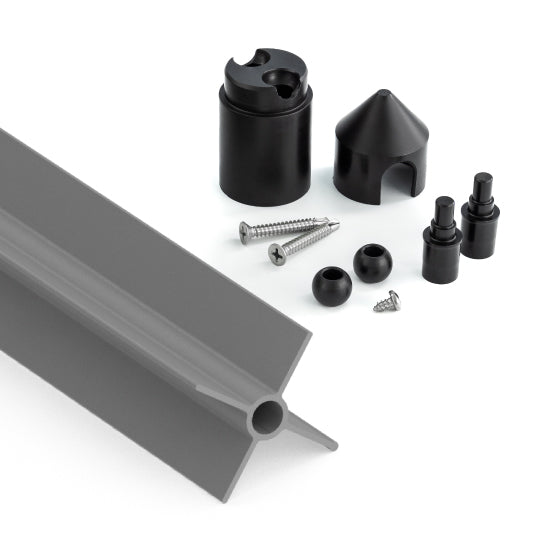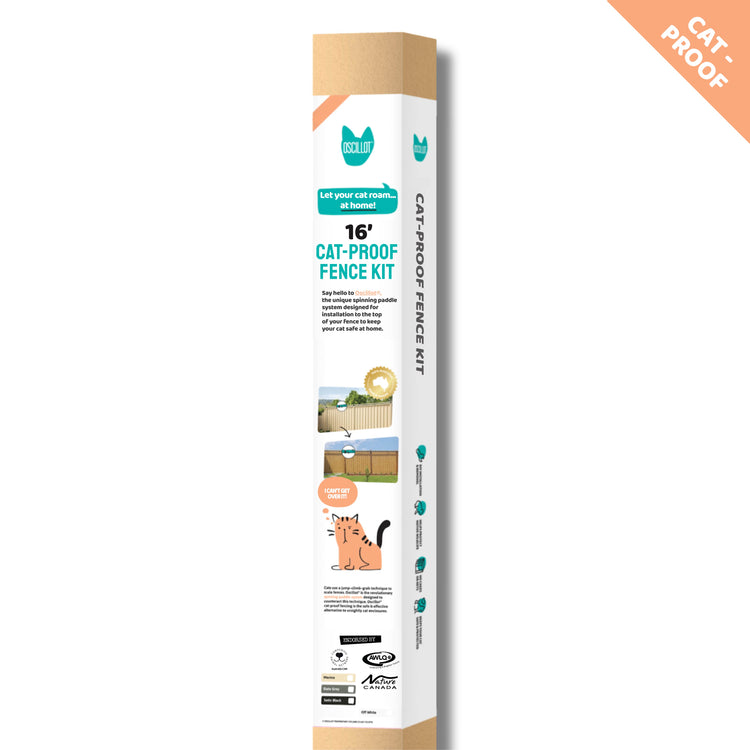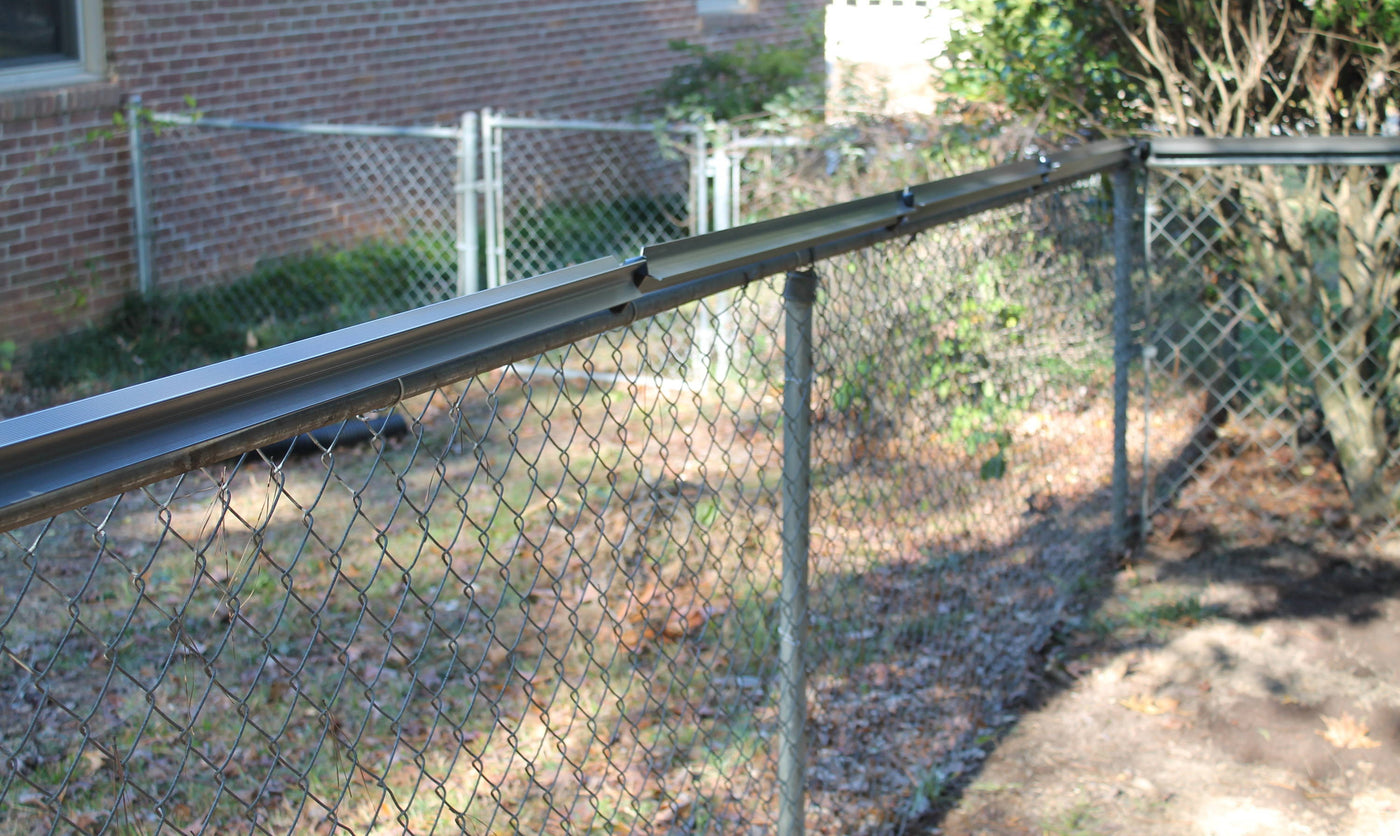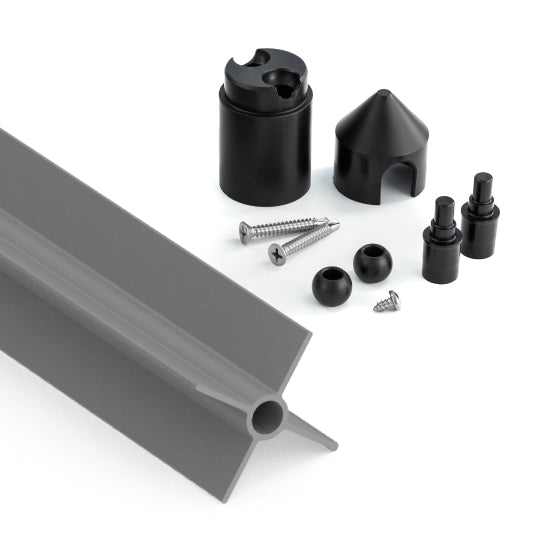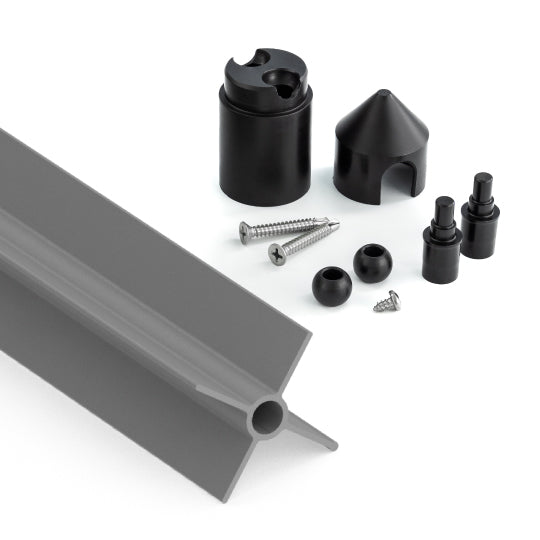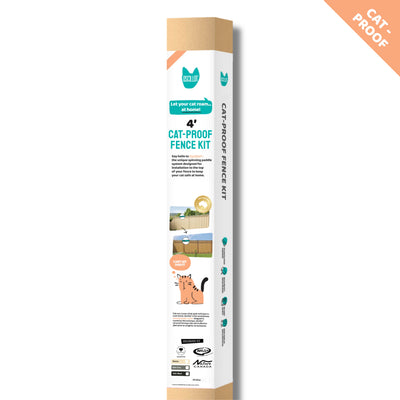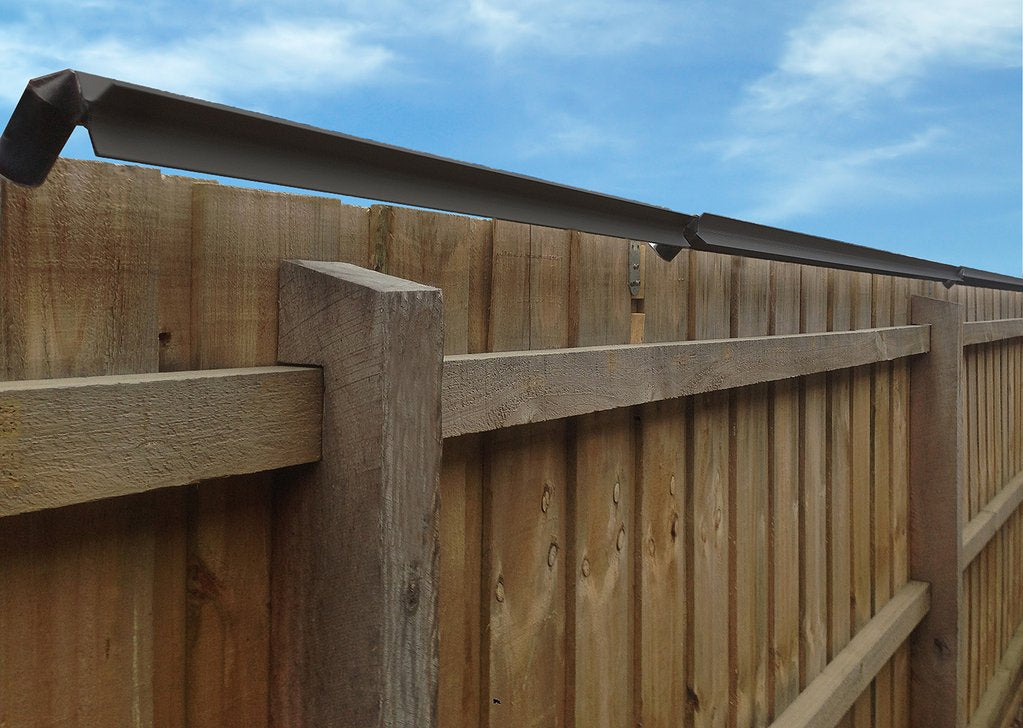Comparing Cat Fence Rollers vs Cat Nets: Which Cat Containment System Is Best?

What You'll Learn About Cat Containment Systems
- Cat fence rollers like Oscillot provide a spinning barrier that prevents cats from climbing over fences
- Cat nets offer mesh coverage but may require more maintenance over time
- Oscillot systems are available in various sizes from 1.2 meters to 62 meters to fit any yard
- Proper installation is crucial for both systems, with a minimum fence height of 1.83 meters recommended
- Rollers typically offer a more aesthetically pleasing solution compared to nets
- Both systems aim to keep cats safe while allowing them outdoor access
Key Takeaways: Cat Containment Systems
| Feature | Oscillot Cat Fence Rollers | Cat Nets |
|---|---|---|
| Effectiveness | Highly effective mechanical barrier that works consistently | Effective when properly maintained; may develop weak spots |
| Installation | Moderate DIY complexity; pre-made components | More labor-intensive; requires careful tensioning |
| Aesthetics | More discreet; multiple color options available | More visible; can create a "caged" appearance |
| Durability | Weather-resistant; minimal maintenance required | Susceptible to tears and UV damage; needs regular inspection |
| Cost | Higher initial investment; lower long-term costs | Lower initial cost; potentially higher replacement costs |
Introduction to Cat Containment Systems
Keeping your cat safe while letting them enjoy the outdoors is a big challenge for pet owners. Cats love to climb and explore, which means regular fences often aren't enough to keep them in your yard. Two popular solutions have emerged to solve this problem: cat fence rollers and cat nets. Both are designed to stop your cat from escaping, but they work in different ways and have their own pros and cons.Cat fence rollers, like the Oscillot® system, create a mechanical barrier that makes it physically impossible for cats to climb over fences. When a cat tries to climb up and over the fence, the rollers spin, causing the cat to slide back down safely into your yard. This system uses physics rather than fear to prevent escapes, making it both humane and highly effective for even the most determined feline escape artists. Cat nets, on the other hand, create a mesh barrier that extends above and sometimes around your existing fence to block climbing and jumping attempts completely. The netting provides a physical obstacle that prevents cats from getting past the boundary of your property.
In this article, we'll compare both cat containment methods in detail. We'll look at how effective they are, how easy they are to install, how they look in your yard, how long they last, and how much they cost. We'll also explore the specific advantages each system offers for different property types, fence configurations, and cat behaviors. By the end, you'll have a clear picture of which system might work better for your specific situation and help keep your feline friend safe while enjoying the outdoors without the risks of free-roaming such as traffic accidents, predators, or getting lost.
Understanding Cat Fence Rollers: The Oscillot® System
The Oscillot® cat containment system is a clever solution for keeping cats safely inside your yard. This system uses spinning paddles mounted along the top of your existing fence to prevent cats from climbing over. When a cat tries to climb the fence and reaches the rollers, the paddles spin, making it impossible for the cat to get a grip, and they safely slide back down. The beauty of this system lies in its simplicity – it works with a cat's natural climbing behavior rather than trying to change it through aversive methods.How Cat Fence Rollers Work
The Oscillot® system has three main parts that work together:1. Paddles - These are the cylindrical rollers that spin when your cat touches them. Made from durable, weather-resistant materials, they rotate freely on their axis to prevent cats from gaining the traction needed to climb over. 2. Dual Knuckle Post Kits - These brackets attach the paddles to your fence. The innovative design allows for proper spacing and alignment to ensure continuous protection along your fence line. 3. Mounting hardware - Designed to work with different fence types including wood, metal, and brick. The specialized hardware ensures secure attachment to various fence materials and configurations.
When properly installed at the top of your fence, the paddles create a barrier that physically stops cats from getting the grip they need to climb over. The system works on a simple principle - cats need to hold onto the top of a fence to successfully climb over it. By replacing that grip point with a spinning roller, cats quickly learn they can't escape that way. The paddles rotate at the slightest touch, providing immediate feedback to your cat that this route is impassable without causing any harm or distress.
Benefits of Oscillot® Cat Fence Rollers
The Oscillot® system offers several advantages that make it a popular choice for cat owners:1. Effectiveness: The mechanical barrier is highly effective at stopping cats from escaping, even for cats that are determined climbers. The system has been tested with thousands of cats worldwide and consistently prevents escapes when properly installed. Even the most athletic and persistent cats typically give up after a few unsuccessful attempts.
2. Looks Good in Your Yard: Unlike mesh systems, the rollers don't stand out too much and can be matched to your fence color with multiple color options available including Koala, Tan, Slate Grey, Merino, Rivergum, Gunmetal Grey, Banyan Brown, Primrose, White, and Satin Black. This variety allows homeowners to select a color that blends with their existing fence and garden aesthetic, maintaining the visual appeal of their outdoor space.
3. Long-Lasting: Made from high-quality plastic and aluminum, the system is built to last outdoors and doesn't need much maintenance. The materials are UV-stabilized to prevent degradation from sun exposure and can withstand various weather conditions including rain, snow, and extreme temperatures. Many installations remain fully functional for 10+ years with minimal maintenance.
4. Works on Most Fences: The system can be installed on most fence types, including wood, metal, brick, and even chain-link fences with the right adaptations. The versatile mounting hardware accommodates different fence materials and thicknesses, making it suitable for virtually any property boundary. Special corner pieces and adaptors are available for unusual fence configurations.
5. DIY-Friendly: Many Oscillot® kits are designed for DIY installation, with clear instructions provided. The components come pre-made and simply need to be attached to your fence, requiring only basic tools and moderate handyman skills. Most homeowners can complete the installation over a weekend.
6. Safe for Your Cat: The system prevents escape without hurting or scaring your cat. Unlike electric fences or spike systems, there's no risk of injury or trauma to your pet. The rollers simply make climbing impossible without causing any discomfort or fear.
Understanding Cat Nets and Mesh Systems
Cat nets take a different approach to cat containment by creating a physical mesh barrier that stops cats from climbing over or jumping from fences. These systems typically involve attaching netting to your existing fence to make it taller and create an inward-facing overhang that cats can't get around. The mesh forms a complete barrier that blocks access to areas beyond your property boundary.How Cat Nets Work
Cat nets work by creating a complete physical barrier that cats cannot get through. The mesh is usually installed with an angle at the top facing inward, preventing cats from climbing over even if they can reach the top of the fence. This angled section is crucial as it creates an obstacle that cats cannot navigate – when they reach the overhang, they cannot continue climbing upward and typically turn back. Some systems also include stakes or barriers at ground level to stop cats from digging under the fence, creating a comprehensive containment solution that addresses multiple escape routes.The netting must be pulled tight and securely attached to work properly. Any loose sections or gaps can give determined cats a way to get through or around the barrier. The mesh size is carefully designed to prevent cats from pushing through or getting their heads stuck, typically featuring openings small enough to prevent passage but large enough to avoid entanglement. Installation usually involves attaching support poles or brackets to extend the height of the existing fence, then securing the netting to these supports with specialized fasteners.
Benefits of Cat Nets
Cat nets offer their own set of advantages:1. Complete coverage: Nets can cover areas where rollers might be difficult to install, such as trees or oddly-shaped structures. The flexible nature of netting allows it to conform to irregular boundaries and obstacles, providing continuous protection even in challenging landscapes. This adaptability makes nets particularly useful for properties with many trees or architectural features near fence lines.
2. You can still see through them: The mesh is typically thin enough that it doesn't completely block your view. This transparency helps maintain visibility through your property while still providing effective containment. The visual impact is minimized compared to solid barriers, allowing light to pass through and preserving sightlines to the surrounding environment.
3. Can be customized: Nets can be cut and shaped to fit unusual fence layouts or to work around obstacles. This flexibility allows for tailored solutions to specific property challenges, accommodating features like garden beds, utility equipment, or decorative elements along the fence line. Custom installations can address the unique requirements of any yard configuration.
4. May cost less upfront: Some netting solutions might have a lower initial cost compared to roller systems, especially for DIY installations. The materials themselves are often less expensive than mechanical systems, making nets an attractive option for budget-conscious pet owners who are willing to invest some time in installation.
5. Protection from above: Nets can also prevent birds of prey from accessing your cat in some setups. When installed as a complete overhead covering, nets create a protective canopy that shields cats from aerial predators like hawks and owls, which can be a concern in some regions. This added protection is beneficial for smaller cats and kittens that might be vulnerable to predatory birds.
However, nets also have several drawbacks, including the potential for damage from weather and wildlife, being more visible than rollers, and needing more frequent maintenance as the mesh can tear or sag over time. Snow and ice accumulation can place additional weight on the netting, potentially causing damage or requiring seasonal adjustments. Additionally, determined cats may test the netting repeatedly, potentially finding weak points or causing wear through persistent attempts.
Comparative Analysis: Rollers vs Nets
When deciding between cat fence rollers and cat nets, you should consider several important factors:1. Effectiveness
Rollers: The Oscillot® system provides a highly effective mechanical barrier that works consistently. Once cats learn they cannot grip the top of the fence, they typically stop trying to escape. The system is particularly effective for determined climbers as it doesn't rely on scaring the cat but creates a physical barrier they simply can't overcome. The rotating action provides immediate feedback to cats that the route is impassable, and most cats quickly learn to stop attempting to climb the fence altogether. The effectiveness doesn't diminish over time, as the mechanical principle remains consistent regardless of how many escape attempts are made.Nets: Nets can be equally effective when properly installed and maintained. However, their effectiveness can decrease if the netting becomes damaged, sags, or if there are any gaps in coverage. Determined cats might find weak spots in netting systems over time. The mesh must remain taut and intact to maintain its effectiveness, requiring regular inspection and adjustment. Environmental factors like heavy snowfall, strong winds, or falling branches can compromise the integrity of the netting, potentially creating vulnerabilities that clever cats might exploit. Additionally, some particularly agile cats may learn to navigate the angled sections if they're not properly designed.
2. Installation Complexity
Rollers: The Oscillot® system installation requires some DIY skills but is designed to be manageable for most homeowners. The parts come pre-made and just need to be attached to your existing fence. Installation typically involves measuring, marking, drilling, and securing the brackets and paddles. The modular nature of the system allows for section-by-section installation, making it possible to complete the project in stages if needed. Comprehensive instructions and installation videos provide step-by-step guidance, simplifying the process for those with basic handyman skills.Nets: Netting installation can be more work, especially for larger yards. It requires careful measurement, cutting, and tensioning to ensure there are no gaps or loose sections. The process often involves more customization for your specific property layout. Installing the support posts or brackets to extend fence height adds an additional layer of complexity, as does properly securing the netting to create the crucial inward angle at the top. The flexible nature of netting makes it more challenging to achieve consistent tension throughout the installation, often requiring specialized tools or techniques to prevent sagging. Professional installation is frequently recommended for netting systems to ensure proper security and longevity.
3. Aesthetics
Rollers: Oscillot® rollers are generally considered more attractive than nets. They're available in multiple colors to match or complement your fence, and they have a clean, unobtrusive profile that blends with most garden designs. The system adds only a small visible element to the top of your fence, maintaining the original appearance of your property boundary. From a distance, the rollers are barely noticeable, especially when color-matched to the fence. This aesthetic advantage is particularly important for homeowners in neighborhoods with strict appearance guidelines or those who take pride in their garden's visual appeal.Nets: Nets are more visible and can create a "caged" appearance that some homeowners don't like. While modern nets are designed to be as unobtrusive as possible, they're still more noticeable than roller systems. The additional height and the inward angle make netting systems a prominent feature of the property boundary. The mesh pattern creates a visual texture that draws attention, particularly when viewed against the sky or landscape backgrounds. Some homeowners associations or neighborhood covenants may have restrictions that limit or prohibit such visible additions to property boundaries.
4. Durability and Maintenance
Rollers: The Oscillot® system is made from weather-resistant materials (plastic and aluminum) designed to handle outdoor conditions. The paddles continue to spin freely with minimal maintenance, typically just needing occasional cleaning to remove leaves or dirt. The UV-stabilized materials resist degradation from sun exposure, and the aluminum components resist corrosion even in coastal environments. The simple mechanical design has few points of failure, contributing to the system's longevity. Most installations remain fully functional for many years without requiring replacement parts or significant maintenance beyond basic cleaning to remove accumulated debris that might impede the rollers' movement.Nets: Netting systems generally require more maintenance. The mesh can tear, especially in bad weather or if wildlife interacts with it. Sun exposure can also break down the material over time, requiring replacement. Regular checks are necessary to make sure the netting remains intact and properly tensioned. UV radiation gradually weakens the synthetic fibers in most netting materials, causing them to become brittle and more susceptible to tearing. Wildlife like birds, squirrels, or raccoons may damage the netting by chewing or clawing at it. Snow and ice accumulation places additional stress on the netting and support structures, potentially causing sagging or breakage. Fallen branches, windblown debris, and other environmental factors can all contribute to premature deterioration of netting systems.
5. Cost Considerations
Rollers: The Oscillot® system is an investment in a durable, long-lasting solution. Prices range from €40 for a 1.2 Metre Kit to €1,619 for a 62 Metre Kit, depending on the size of your yard. While the initial cost might be higher than some netting solutions, the durability and low maintenance requirements often make it more economical in the long run. The system's longevity means the cost is spread over many years of effective use, resulting in a lower annual cost of ownership. Additionally, the system can be transferred to a new fence if you replace your existing fence in the future, preserving your investment.Nets: Netting systems often have a lower initial cost, particularly for DIY installations. However, the potential need for repairs or replacement over time should be factored into the overall cost calculation. The more frequent maintenance requirements may also incur additional expenses or time commitments. If professional installation is required, this can significantly increase the initial investment. The shorter lifespan of netting materials means that complete replacement may be necessary every few years, especially in areas with extreme weather conditions. When calculating the true cost of ownership, these ongoing expenses must be considered alongside the initial purchase price.
Choosing the Right Size Oscillot® System for Your Property
Selecting the appropriate size for your cat containment system is crucial for effective installation and performance. Oscillot® offers a range of kit sizes to accommodate various property dimensions:Small Yard Solutions
For smaller yards or specific sections of fencing, Oscillot® offers compact kits:- 1.2 Metre Kit (€40): Includes 1 paddle and 2 dual knuckle post kits. This starter kit is perfect for securing a single gate or testing the system on a small section of your fence before committing to a larger installation. It's also useful for closing small gaps or vulnerable points in your existing containment setup.
- 2.5 Metre Kit (€64): Includes 2 paddles and 3 dual knuckle post kits. This kit provides enough coverage for a standard garden gate plus a small section of adjacent fencing, or for securing a small garden bed area. The additional paddle compared to the smallest kit offers more comprehensive protection for vulnerable escape points.
- 5 Metre Kit (€112): Includes 4 paddles and 5 dual knuckle post kits. This option is suitable for small courtyard gardens, townhouse backyards, or specific problem areas in larger properties. It provides enough coverage to secure the most vulnerable sections of a modest-sized outdoor space.
These smaller kits are perfect for securing a gate, a small garden section, or for testing the system before investing in coverage for a larger area. They also allow for targeted protection of known escape routes without the expense of covering the entire property perimeter. Many cat owners start with these smaller kits to address specific problem areas before expanding the system as needed.
Medium Yard Solutions
For medium-sized yards, these options provide comprehensive coverage:- 6.2 Metre Kit (€190): Includes 5 paddles and 7 dual knuckle post kits. This mid-range option provides enough coverage for a small to medium backyard or garden area. It's particularly suitable for townhouses, duplex properties, or urban homes with modest outdoor spaces. The kit includes enough components to secure most standard backyard boundaries with some flexibility for corners and gates.
- 12.4 Metre Kit (€360): Includes 10 paddles and 12 dual knuckle post kits. This popular size accommodates typical suburban backyards, providing enough coverage for a standard quarter-acre property. The kit offers comprehensive protection for medium-sized outdoor spaces, with sufficient components to navigate multiple corners and access points. It's an excellent balance of coverage and value for average family homes.
- 18.6 Metre Kit (€424): Includes 15 paddles and 19 dual knuckle post kits. This larger medium option is designed for more spacious suburban properties or homes with irregular fence lines requiring more coverage. The additional components provide flexibility for properties with multiple garden beds, outbuildings, or complex boundary configurations.
These mid-range options are the most popular choices for typical suburban yards and provide excellent value for the coverage area. They offer enough components to secure the entire perimeter of average-sized properties while accommodating standard features like gates, corners, and garden beds. The kit sizes are strategically designed to match common property dimensions, minimizing waste and ensuring efficient use of materials.
Large Property Solutions
For larger properties or complete perimeter protection, Oscillot® offers extensive kits:- 24.8 Metre Kit (€680): Includes 20 paddles and 24 dual knuckle post kits. This comprehensive solution is designed for larger suburban properties, providing enough coverage to secure the entire perimeter of a standard quarter to half-acre lot. The kit includes sufficient components to navigate multiple corners, gates, and other boundary features while maintaining continuous protection around the property.
- 37.2 Metre Kit (€816): Includes 30 paddles and 36 dual knuckle post kits. This extensive option is suitable for larger residential properties, rural homes, or properties with complex boundaries requiring significant coverage. The kit provides enough components to secure sprawling gardens, acreages with dedicated cat enclosures, or properties with multiple fenced sections requiring protection.
- 62 Metre Kit (€1,619): Includes 50 paddles and 56 dual knuckle post kits. This maximum coverage option is designed for estate properties, large rural homesteads, or commercial facilities requiring comprehensive cat containment. The extensive kit provides enough components to secure very large properties with complex boundaries, multiple access points, and various fence types.
These comprehensive kits are ideal for larger properties, rural homes, or situations where complete perimeter security is required. They provide economies of scale, with the per-meter cost decreasing as the kit size increases. The larger kits also ensure consistency in appearance and performance across the entire installation, with all components coming from the same manufacturing batch. For extensive properties, these complete solutions eliminate the need to purchase multiple smaller kits, simplifying the ordering process and installation logistics.
Installation Considerations for Both Systems
Fence Height Requirements
Both roller and netting systems have minimum fence height requirements to be effective:Oscillot® System: Recommends a minimum fence height of 1.83 meters (6 feet) for best results. This height, combined with the rollers, prevents most cats from being able to jump over the system. The recommended height is based on extensive testing with cats of various jumping abilities and ensures that even athletic felines cannot clear the fence in a single bound. For fences slightly below this height, the Oscillot system can still be effective, but may require additional measures for exceptionally athletic cats. The critical factor is that the combined height of the fence plus the roller system must exceed a cat's maximum jumping ability.
Cat Nets: Typically require similar minimum fence heights, though some systems may need additional height to accommodate the inward-angled overhang. The angled section at the top of netting systems adds effective height to the barrier, as cats must navigate both the vertical climb and the inward-facing overhang. For lower existing fences, netting systems often require the installation of extension posts to achieve adequate height, adding to the complexity and visibility of the installation. The netting itself must extend high enough to prevent cats from jumping over it, while the inward angle creates an additional barrier that most cats cannot navigate.
Fence Type Compatibility
Oscillot® System: Works with most fence types including:- Wood fences: The brackets can be directly attached using wood screws, making installation straightforward on timber fencing. - Metal fences: Special brackets and mounting hardware accommodate tubular steel, wrought iron, and other metal fence designs. - Brick and masonry walls: Masonry anchors and specialized mounting techniques secure the system to solid walls. - Chain-link fences (with adaptations): While more challenging, adaptor brackets allow installation on chain-link fencing with proper reinforcement. - Colorbond and other panel fencing: The system attaches easily to these popular fence types with standard mounting hardware.
The versatility of the Oscillot® mounting system means it can be adapted to virtually any stable fence structure with the appropriate hardware and installation techniques. The dual knuckle post kits are designed with adjustability to accommodate various fence thicknesses and profiles, ensuring secure attachment regardless of fence material.
Cat Nets: Generally adaptable to most fence types but may require different attachment methods depending on the material. Some fence types may present challenges for secure attachment of netting. Chain-link fences, for example, provide numerous attachment points but may require reinforcement to support the tension of properly installed netting. Solid walls need specialized anchoring systems to secure both the support posts and the netting itself. Ornamental fences with irregular tops may require custom adaptations to ensure continuous protection without gaps. The flexibility of netting can be both an advantage and a challenge, as it must be securely fastened at frequent intervals to maintain proper tension.
DIY vs Professional Installation
Oscillot® System: Designed for DIY installation with comprehensive instructions provided. The installation process typically involves:1. Measuring and marking fence posts: Accurate measurement ensures consistent height and proper alignment of the roller system. 2. Attaching brackets at the appropriate height: The dual knuckle post kits must be securely fastened to support the weight and movement of the paddles. 3. Installing the paddles and ensuring they spin freely: Proper assembly ensures the rollers rotate smoothly at the slightest touch. 4. Testing the system: Once installed, the paddles should spin easily to confirm they'll function correctly when a cat attempts to climb the fence.
The modular design allows for installation in sections, making it manageable for homeowners to complete over multiple sessions if needed. The pre-manufactured components eliminate the need for custom fabrication, simplifying the installation process. Most homeowners with basic DIY skills and tools can successfully install the system, though assistance may be helpful for larger installations or when working with challenging fence types.
Cat Nets: Can be installed DIY but may be more challenging due to the need for proper tensioning and securing. Professional installation is often recommended for larger areas or complex fence configurations. The installation process typically requires:
1. Installing support posts or brackets to extend fence height 2. Cutting netting to size for each section 3. Carefully securing the bottom edge to prevent gaps 4. Creating the proper inward angle at the top 5. Tensioning the netting to eliminate sagging 6. Securing all edges and seams
The process requires more customization and adaptation to the specific property, making it more time-consuming and potentially frustrating for DIY installers. The flexible nature of the netting means that proper tensioning is critical but can be difficult to achieve consistently. Professional installers have specialized tools and techniques to ensure proper installation, which may justify the additional expense for many homeowners.
Common Challenges and Solutions
Dealing with Trees and Climbing Aids
One of the biggest challenges for any cat containment system is addressing trees, structures, or other objects that cats might use to bypass the system.Oscillot® Solution: For properties with trees near fence lines, the Oscillot® system can sometimes be adapted to encircle tree trunks. This involves custom installation of brackets to create a collar of rollers around the tree at the appropriate height. For trees that cannot be directly protected with rollers, tree guards or barriers can be installed to prevent cats from using trees as escape routes. These typically involve smooth metal or plastic collars around the trunk that prevent climbing, similar to the principles used to protect bird feeders from squirrels. For properties with numerous trees along the boundary, it may be more practical to create an internal perimeter with the Oscillot system that excludes the trees but still provides a generous secure area for cats to enjoy.
Cat Net Solution: Netting can sometimes be extended to include trees within the contained area, or separate tree barriers can be installed. For properties with significant tree coverage, netting can be installed as an overhead canopy connecting from the fence to the trees, creating a fully enclosed space. This approach allows cats to enjoy the trees while remaining contained. Alternatively, individual trees can be protected with specialized tree guards or netting collars that prevent cats from climbing beyond a certain height. For properties where trees are a major feature, the flexibility of netting may offer advantages in creating custom solutions that accommodate the natural landscape while maintaining effective containment.
Corner and Gate Considerations
Corners and gates present unique challenges for both systems:Oscillot® System: Special corner brackets are available to ensure continuous protection around corners. These brackets are designed to maintain the proper angle and spacing of the paddles as they navigate the change in fence direction. Gate kits are also available to secure access points while maintaining functionality. These typically involve mounting the rollers directly to the gate structure, ensuring that the protection remains continuous even when the gate is in use. For complex gate configurations, custom solutions can be developed using the standard components with specialized mounting techniques. The system can accommodate both inward and outward opening gates, as well as sliding gates, with appropriate adaptations.
Cat Nets: Require careful planning and installation at corners to ensure there are no gaps. The netting must be securely fastened at corners with enough overlap to prevent cats from finding a way through. Gates typically need custom solutions to maintain security while allowing human access. These often involve creating separate netting panels that can be fastened and unfastened as needed, or designing overlapping sections that maintain security while allowing passage. The flexibility of netting allows for creative solutions to these challenges, but proper implementation requires careful planning and execution. Professional installers often have standard approaches for addressing corners and gates that have proven effective in various installations.
Weather and Durability Concerns
Oscillot® System: Made from UV-resistant materials designed to withstand various weather conditions. The high-quality plastics used in the paddles are specifically formulated to resist degradation from sun exposure, preventing brittleness and color fading over time. The aluminum components are naturally corrosion-resistant, making the system suitable for coastal environments and areas with high rainfall. The system is generally maintenance-free, though occasional cleaning may be required to remove debris that could stop the rollers from spinning properly. Leaves, twigs, and other windblown materials can sometimes accumulate in the brackets or around the paddles, but these are easily removed with a quick brush or rinse. The system's durability in extreme weather conditions has been proven through installations in diverse climates worldwide.Cat Nets: More susceptible to weather damage, including UV breakdown, wind damage, and potential tearing from debris. The synthetic materials used in most netting systems gradually degrade when exposed to sunlight, becoming more brittle and prone to tearing over time. High winds can place significant stress on the netting and its attachment points, potentially causing sections to tear or detach. Heavy snow or ice accumulation adds weight that the system may not be designed to support, potentially causing sagging or structural failure. Regular inspection and maintenance are necessary to ensure continued effectiveness, including checking for tears, sagging sections, and secure attachment points. In regions with extreme weather conditions, more frequent maintenance or even seasonal adjustments may be required to maintain the system's integrity.
Real-World Performance and Customer Experiences
Cat Owner Perspectives
Most cat owners report high satisfaction with the Oscillot® system, noting that their cats quickly learn that escape attempts are futile. The system's effectiveness combined with its unobtrusive appearance makes it a popular choice for homeowners concerned about both functionality and aesthetics.
While we don't have direct customer testimonials included here, the comprehensive guide to cat-proof fencing types on our blog provides additional insights from real users.
Adaptation Period
Both systems typically require an adjustment period for cats:Oscillot® System: Most cats will test the system a few times before learning that they cannot climb over. This learning process is generally quick and stress-free, as the cat simply slides back down without harm. The immediate physical feedback provided by the spinning rollers helps cats quickly understand that the fence is no longer a viable escape route. Most cats adapt within a few days to a week, with even determined escape artists eventually accepting the new boundaries. The system works with the cat's natural intelligence – once they realize that climbing attempts consistently fail, they typically stop trying and redirect their energy to exploring within the contained area. This behavioral adaptation occurs without negative reinforcement or stress, making it a humane solution that respects the cat's natural instincts.
Cat Nets: Cats may test the netting more persistently, potentially causing damage to the mesh if they're particularly determined. The visual barrier may also cause initial confusion for some cats. Unlike the mechanical feedback provided by rollers, nets rely on creating a physical obstacle that cats must learn to recognize and respect. Some cats may repeatedly test different sections of the netting, looking for weaknesses or gaps. The adaptation period can vary significantly depending on the cat's personality and determination, with some accepting the new boundaries quickly while others continue testing the system for weeks. The visual nature of the barrier can help cats recognize the boundary more readily, but may also cause some initial stress as they adjust to the changed appearance of their territory.
Cost-Benefit Analysis Over Time
When considering the long-term value of each system, several factors come into play:Initial Investment
Oscillot® System: Ranges from €40 for a 1.2 Metre Kit to €1,619 for a 62 Metre Kit. Medium-sized yards typically require an investment of €360-€680. This pricing reflects the quality of materials used, the engineering of the components, and the comprehensive nature of the kits, which include all necessary hardware for installation. The modular design allows homeowners to start with critical areas and expand the system over time if budget constraints are a concern. While the upfront cost is significant, the system represents an investment in a permanent solution rather than a temporary fix.Cat Nets: Initial costs vary widely depending on quality and coverage area, but are often lower than roller systems for comparable coverage. Basic DIY netting kits for small areas can start at under €100, while comprehensive systems for larger properties can reach several hundred euros. The quality of materials significantly impacts the price, with premium UV-resistant netting commanding higher prices but offering better durability. If professional installation is required, this adds substantially to the initial investment, potentially narrowing or eliminating the cost advantage compared to roller systems. The price range reflects the variety of materials, designs, and installation methods available in the market.
Maintenance Costs
Oscillot® System: Minimal ongoing costs, with occasional cleaning being the main maintenance requirement. The durable construction means replacement parts are rarely needed. Most owners report spending just minutes per year on maintenance, typically just removing accumulated debris that might prevent the rollers from spinning freely. The system doesn't require specialized cleaning products or tools – a simple brush or garden hose is usually sufficient. In the rare event that a component needs replacement due to damage, individual parts can be purchased separately without replacing the entire system. This modular approach to repairs keeps long-term maintenance costs extremely low.Cat Nets: Higher maintenance costs over time, potentially including repairs or complete replacement of netting as it degrades or becomes damaged. Tears in the netting require immediate attention to maintain effectiveness, often necessitating patch kits or replacement sections. UV degradation eventually weakens even high-quality netting, requiring complete replacement every few years in sunny climates. The tension of the netting must be maintained to prevent sagging, sometimes requiring readjustment or replacement of attachment hardware. These ongoing maintenance requirements represent both direct costs for materials and indirect costs in terms of time and effort. For homeowners who value low-maintenance solutions, these considerations may outweigh the potential initial cost savings.



